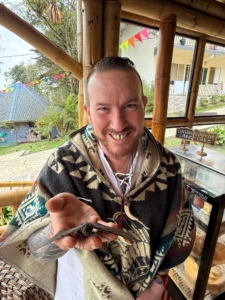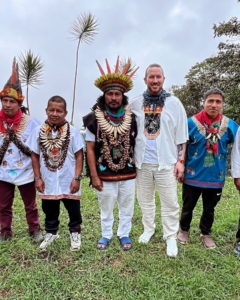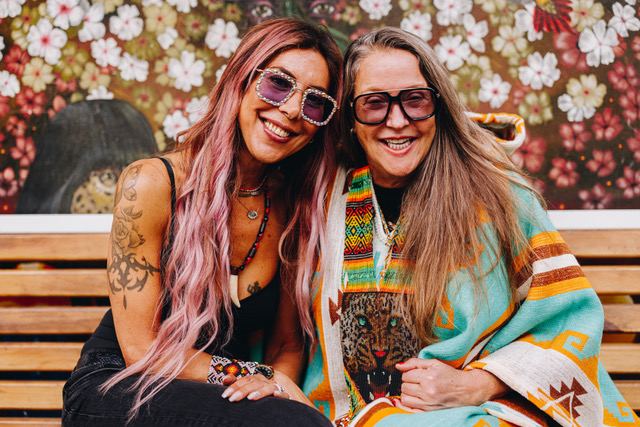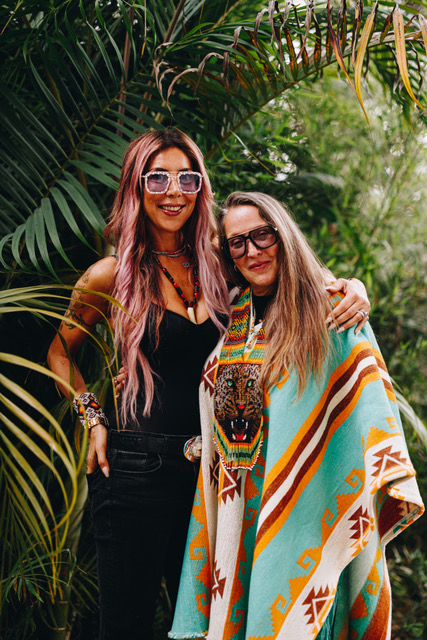Rapé: Insights of medicine man, Diego Gallardo
 Diego Gallardo, a ceremonial practitioner and medicine man, is a bridge between ancient Indigenous traditions and contemporary understanding. Known for his reverence for plant medicines and his commitment to honoring their origins, Diego embodies the concept of two-eyed seeing—combining Indigenous wisdom with a grounded approach to sharing these sacred practices with others. In his teachings, Diego shares not only the technical aspects of working with plant medicines but also the spiritual depth, intention, and respect that must accompany them. Among these, Rapé (or Hapé) stands out as a powerful medicine for grounding and connection.
Diego Gallardo, a ceremonial practitioner and medicine man, is a bridge between ancient Indigenous traditions and contemporary understanding. Known for his reverence for plant medicines and his commitment to honoring their origins, Diego embodies the concept of two-eyed seeing—combining Indigenous wisdom with a grounded approach to sharing these sacred practices with others. In his teachings, Diego shares not only the technical aspects of working with plant medicines but also the spiritual depth, intention, and respect that must accompany them. Among these, Rapé (or Hapé) stands out as a powerful medicine for grounding and connection.
What is Rapé?
Rapé (pronounced rrah-peh or ha-peh) is a sacred, finely ground powder traditionally used by Indigenous tribes of the Amazon. At its core, Rapé is composed of fermented and roasted Mapacho tobacco leaves, often combined with other natural ingredients like seeds, flowers, herbs, roots, and tree ashes. Each tribe has its own unique recipe, blending ingredients with specific spiritual or medicinal properties.
Rapé is deeply revered not as a recreational substance but as a medicine—one that does not contain any psychoactive properties. Instead, it serves as a spiritual tool for grounding, energetic cleansing, and fostering a deep sense of connection to the present moment.
Why is Rapé Used?
Diego explains that Rapé is more than just a tool; it is an ally in ceremonial and everyday life. It is used for a variety of purposes, such as:
- Grounding and Centering: Bringing the user back to the present moment and aligning their mind, body, and spirit.
- Cleansing: Purging negative energy, clearing mental and emotional blockages, and cleansing the pineal gland.
- Physical Relief: Alleviating headaches, reducing stress, and clearing nasal passages.
- Facilitating Deep Connection: Diego describes how Rapé quiets the mind and calms the heart, allowing individuals to engage in honest, heartfelt communication.
How is Rapé Used?
 Rapé is administered through the nostrils, either by oneself using a Kuripe (a self-blowing pipe) or by another person using a Tepi (a ceremonial pipe designed to blow Rapé into someone else’s nose). Diego emphasizes the importance of intention and respect in this process. “It’s not just blowing powder into someone’s nose,” he says. “You have the responsibility to honor the medicine, the tribes, and the spirit of the plants.”
Rapé is administered through the nostrils, either by oneself using a Kuripe (a self-blowing pipe) or by another person using a Tepi (a ceremonial pipe designed to blow Rapé into someone else’s nose). Diego emphasizes the importance of intention and respect in this process. “It’s not just blowing powder into someone’s nose,” he says. “You have the responsibility to honor the medicine, the tribes, and the spirit of the plants.”
 The administration begins with prayers or intentions. The first blow clears the nasal passages, creating space for deeper energetic work. Subsequent applications help realign energy, ground the user, and foster presence. Diego often highlights the role of the administrator, who must match their energy to the moment and respect the connection between the participants, the medicine, and the ceremonial space.
The administration begins with prayers or intentions. The first blow clears the nasal passages, creating space for deeper energetic work. Subsequent applications help realign energy, ground the user, and foster presence. Diego often highlights the role of the administrator, who must match their energy to the moment and respect the connection between the participants, the medicine, and the ceremonial space.
Diego’s Insights and Leadership
Diego’s storytelling reflects his deep connection to Rapé and the wisdom he carries from years of working with Indigenous medicines. A few key takeaways from his teachings include:
- Respect for the Medicine: Diego underscores the sacred nature of Rapé. He explains that each blend and tool carries unique energy and intention, and selecting the appropriate one is guided by intuition and the needs of the moment.
- Creating Presence: Rapé helps individuals quiet their minds and speak from their hearts, a practice often used in communal spaces like the Maloka (tribal longhouse). It fosters deep, meaningful conversations that are rooted in authenticity and clarity.
- Grounding After Ceremony: Rapé is often used to help participants integrate after energy-intensive ceremonies. Diego shares how the medicine realigns scattered energies and brings people back into balance.
- Misconceptions: Diego addresses misunderstandings around Rapé, particularly the false notion that it has psychedelic properties or can release trauma on its own. Instead, he explains that its power lies in its ability to ground and center, creating a space for healing to take place.
- The Role of the Practitioner: “You are a vessel,” Diego shares, describing how the administrator reflects the energy of the recipient. This requires humility, deep listening, and a commitment to honoring the medicine and its origins.
The Takeaway: A Story Told Through Two-Eyed Vision
 Diego’s teachings are not merely technical; they are an invitation to view Rapé through a lens of respect, intention, and interconnectedness. As he leads us through the layers of this sacred medicine, Diego demonstrates what it means to walk the path of a medicine man—bridging the physical and spiritual worlds, holding space for transformation, and sharing wisdom rooted in ancestral tradition. In his hands, Rapé becomes more than a powder—it is a tool for presence, healing, and connection, carried forward with reverence for its Indigenous roots.
Diego’s teachings are not merely technical; they are an invitation to view Rapé through a lens of respect, intention, and interconnectedness. As he leads us through the layers of this sacred medicine, Diego demonstrates what it means to walk the path of a medicine man—bridging the physical and spiritual worlds, holding space for transformation, and sharing wisdom rooted in ancestral tradition. In his hands, Rapé becomes more than a powder—it is a tool for presence, healing, and connection, carried forward with reverence for its Indigenous roots.
Connect with Diego on instagram (@Diego_Arctic_PlantMedicine_Man). And to source ethically and sustainably sourced Rapé and/or tools, please support the wonderful team behind Four Visions Apothecary.







